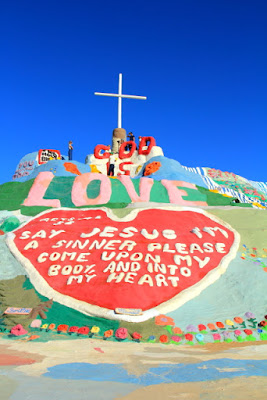Since we were in Calexico, we decided to go over to Mexicali to do some shopping; but much to our surprise, Mexicali is not the typical Mexican border town with all of the cute little shops that cater to U.S. Tourist. Mexicali is primarily a business community. So, we only stayed long enough to purchase some vanilla and then headed back to Calexico. Unfortunately, we still had to wait in a long line of people that were trying to enter the US.
W.E. Holt established the town of Holtville in 1903 and then went on to built the first electric power plant, the Holton Interurban Railroad, started the first church and the first newspaper, and donated land for a park. Hoteville is primarily an agricultural community that grows a lot of produce and is known at the "Carrot Capital of the World." Unfortunately, we missed that annual Carrot Festival and I had really wanted to try a carrot malt!
The City of Brawley has a significant cattle and feed industry and is known as the "Home of the Cattle Call." Yahoo!
Calipatria is located 184 feet below sea level, which makes it "The Lowest Down City in the Western Hemisphere." However, the top of their flagpole is 184 feet tall; so if the dike ever breaks, the people of Calipatria can gather at the top of the flagpole and be saved!
The Sonny Bono Salton Sea National Wildlife Refuge is located along the Pacific Flyway, which is one of the major north-south flyways for migratory birds and extends from Alaska to Patagonia. Originally, the Refuge contained 37,600 manageable acres; but after the Salton Sea flooded the low lands, only about 2,200 acres are now manageable.
Geothermal activity is prevalent in the area and we counted five active geothermal electrical plants within a short distance of the Refuge.
Slab City received its name from concrete slabs that are the remnant of Camp Dunlap, an old WW II Marine training grounds. Only the barracks' slabs remain, but the slabs make great places for visitors to park their campers or build shelters.
People that live in Slab City year-round are called "Slabbers." Many of the "Slabbers" receive some type of government subsistence, but others just want to live off of the grid and to be left alone. There is no electricity, running water, sewer, or trash pickup in Slab City; but they do have a solar powered Internet Cafe and a shoe tree where you can leave or pick up a pair of shoes!!
Many people in Slab City decorate their vehicles to match their shelters and one of the thing that really amazed me is that I did not see any posted properties. In fact, just the opposite! Many properties had a welcome sign and invited people to just drop in for a visit and have something to eat, drink, and participate in other activities to be merry.
There is no employment base in Slab City that I know of, but I was told that many residents donate time working at the Salvation Mountain facility.
As I was leaving Slab City, I liked the sign that said: "CAUTION! Reality Ahead."
Adjacent to Slab City is the World Famous Salvation Mountain. In an address to the United States Congress on May 15, 2002, California Senator Barbara Boxer described Salvation Mountain as "a unique and visionary sculpture... a national treasure... profoundly strange and beautifully accessible, and worthy of the international acclaim it receives."
Salvation Mountain was created by Leonard Knight (1931-2014) and is made from adobe, straw, trees, scrap materials, and thousands of gallons of paint. There are numerous murals, Christian sayings, and Bible verses throughout the complex.
Since the death of Mr. Knight, many people have been concerned with the future of the structure because of safety and health concerns. The complex requires constant maintenance, which is currently performed by a group of volunteers, and most of the paint used in the early years was lead-based.
If you would like to volunteer to help with the maintenance, there is free parking at Slab City!
Bombay Beach (population 295 in 2010) is an unincorporated community located on the shore of Salton Sea and is the lowest unincorporated community in America at 223 feet below sea level. The population of Bombay Beach has been on the decline in recent years and now there are a lot of abandoned structures in the area.
Time to get to a higher altitude before it starts to rain!
 |
| Salton Sea |




































No comments:
Post a Comment